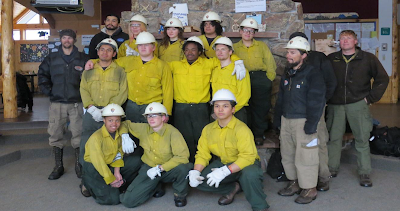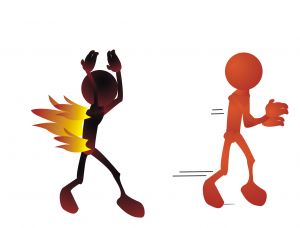"Leading change in any organization requires the courage to start, commitment to stay the course, and the character to set the bar and more importantly to admit when we are wrong. Firefighting is the province of danger and courage is a critical element of the firefighter. Courage is hard to describe but easily noticeable when displayed."
Between 2012 and 2013 the Minidoka Ranger District fire management organization saw significant turnover in several key leadership position including the fire management officer, assistant fire management officer, as well as several new faces on the three engine modules. With so many new individuals in the organization, the timing was right to create a new future for the organization. The goal of this endeavor was to create a culture based on shared values and principles with transparency in leadership to guide the organization in a positive direction in all actions. We took several steps to accomplish this lofty goal.
We started this endeavor by creating a vision for the organization; building on past successes while overcoming the lingering barriers, and anticipating ways to capitalize on the future. Our vision is to create a resilient organization that capitalizes on the strengths and differences of the individual, encouraging diversity in ideas and approaches to solving problems and achieving goals. From this vision, as an organization we fashioned a mission statement that defined who and what we are as an organization. After we defined our mission we identified and described values that would serve as the foundation for our organization to carry out that mission. We used our values and principles to develop standard operating procedures and guidelines for the organization and modules to create a common operating picture.
- Safety: Safety is the outcome of our culture of shared beliefs, practices, and positive attitudes and is reflected in all that we do.
- Respect: Know your subordinates and look out for them. Build the team.
- Integrity: Do the right thing even when no one is looking.
- Accountability: Make decisions with the knowledge that your actions control not only your destiny, but the programs also.
- Professionalism: Take pride in your appearance, work ethic, and attitude.
- Innovation: Recognize new ideas, support those ideas, have the courage to act.
- People: Value the individual; treat each other with dignity, respect, and honor.
- Team: Come together, share together, and succeed together.
After we identified the values and principles that we hold ourselves to, we began the process of developing training curriculum that would build on these values. The training curriculum was designed with all levels of experience in mind with a focus on building leadership skills and overall organization capacity in fire management. The process of developing and delivering our own training content served two purposes:
- First and foremost it provided our employees with an in-depth refresher and expanded their knowledge base and skill sets.
- Secondarily those individuals who helped build the curriculum were able to work on small unit leadership skills.
The training was delivered over a two-week time frame with emphasis on extensive drills in the field creating a shared experience and establishing a common operating picture for the fire management organization. For a large part of the leadership-focused training, we used Michael Useem’s
The Leadership Moment and
Band of Brothers as an impetus for discussing leadership principles and values. Every employee received a copy of
The Leadership Moment. We utilized various sections of the book to facilitate discussions on designated training days. Throughout the summer, sand table exercises and tactical decision games where used in the morning briefing in conjunction with 6 Minutes for Safety's “This Day in History” and “Lead Time” topics.
Leading change in any organization requires the courage to start, commitment to stay the course, and the character to set the bar and more importantly to admit when we are wrong. Firefighting is the province of danger and courage is a critical element of the firefighter. Courage is hard to describe but easily noticeable when displayed.
Courage comes in two kinds. First is physical courage that is courage in the face of danger. Next is moral courage the courage above the values of duty, respect and integrity. It is the responsibility to make those values real for others to see creating the character of the leader. In the publication
Leading in the Wildland Fire Service "moral courage" is describe as “adhering to high ethical standards choosing the difficult right over the easy wrong. To avoid ethical dilemmas by directing team members to operate in way that are consistent with our professional values.”
Another part of moving the organization into the future was creating a new image. To brand the organization a new logo was created that would represent and unify individuals as part of the Minidoka Ranger District Fire Management organization. This logo is worn with pride by all members of the group.
*********************************************
The above information was adapted from the Minidoka Ranger District's application for the 2013 Wildland Fire Leadership Challenge - From the Field for the Field contest. A special thanks to Heath Cota, Fire Management Officer, for this write-up.









